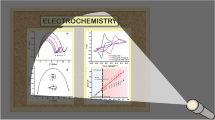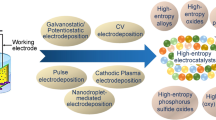Abstract
Using the methods of quartz microgravimetry and voltammetry, the anodic behavior of gold electrode in thiosulfate electrolytes is studied in the pH range of 7 to 11. It is found that, in the potential range from 0.15 to 1.0 V (NHE), the anodic current is associated predominantly with the oxidation of thiosulfate ions, and the gold dissolution rate in this electrolyte is negligibly low (< 0.02 mA/cm2). It is shown that the study of anodic processes in the neutral thiosulfate electrolytes requires stabilization of solution acidity, because the near-anode layer can be acidified to the pH values, which are sufficient for the formation of elemental sulfur. It is found that the use of Britten-Robinson buffer solution with pH 7 as the supporting electrolyte changes significantly the polarization curve of thiosulfate ion oxidation, but does not raise the gold dissolution rate. An increase in the solution pH to 11 and an exposure of electrode at various potentials (−0.5 and 0.15 V) prior to the onset of potential scanning also do not accelerate considerably the gold dissolution in the thiosulfate electrolyte. A comparison between the regularities of gold anodic behavior in the thiosulfate solutions and earlier studied gold dissolution in the cyanide and thiocarbamide electrolytes showed that they are similar. It is supposed that the specific features of anodic processes in these cases are of a similar nature: the metal dissolution proceeds with the formation of two-ligand complexes with linear structure, which is typical for all aforementioned ligands.
Similar content being viewed by others
References
Spravochnik po elektrokhimii (Handbook of Electrochemistry), Sukhotin, A.M., Ed., Leningrad: Khimiya, 1981.
Pedraza, A.M., Villegas, I., Freund, P.L., and Chornik, B., J. Electroanal. Chem., 1988, vol. 250, p. 443.
Zhuchkov, I.A. and Bubeev, P.P., Izv. Vyssh. Uchebn. Zaved. RF., Tsvetn. Metall., 1992, nos. 3–4, p. 85.
Zhuchkov, I.A. and Bubeev, P.P., Izv. Vyssh. Uchebn. Zaved. RF., Tsvetn. Metall., 1994, nos. 4–6, p. 123.
Shevtsova, O.N., Bek, R.Yu., et al., Elektrokhimiya, 2006, vol. 42, p. 279 [Russ. J. Electrochem. (Engl. Transl.), vol. 42, p. 239].
Aleksandrova, T.P., Ovchinnikova, S.N., Vais, A.A., and Bek, R.Yu., Zh. Anal. Khim., 1999, vol. 54, p. 732 [J. Anal. Chem. (Engl. Transl.), vol. 54, p. 646].
Gabrielli, K. and Keddam, M., Elektrokhimiya, 1993, vol. 29, p. 117 [Russ. J. Electrochem. (Engl. Transl.), vol. 29, p. 106].
Gabrielli, C., Keddam, M., and Torresi, R., J. Electrochem. Soc., 1996, vol. 138, p. 2657.
Vatankhah, G., Lessard, J., Jerkiewicz, G., Zolfaghari, A., and Conway, B.E., Electrochim. Acta, 2003, vol. 48, p. 1613.
Zelinskii, A.G. and Bek, R.Yu., Elektrokhimiya, 1985, vol. 21, p. 66.
Kletenik, Yu.B. and Aleksandrova, T.P., Zh. Anal. Khim., 1997, vol. 52, p. 752 [J. Anal. Chem. (Engl. Transl.), vol. 52, p. 680].
Woods, R., Hope, G.A., Watling, K.M., and Jeffrey, M.J., J. Electrochem. Soc., 2006, vol. 153, p. D105.
Vetter, K.J., Elektrochemische Kinetik, Berlin: Springer, 1961.
Dobos, D., Electrochemical Data. A Handbook for Electrochemists in Industry and Universities, Budapest: Akadémiai Kiádó, 1978.
Kakovskii, I.A., Izv. Akad.Nauk SSSR, Otd. Tekhn. Nauk, 1959, no. 7, p. 29.
Pouradier, J. and Gadet, M.C., J. Chem. Phys., 1969, vol. 66, p. 109.
Angerstein-Kozlowsta, H., Conway, B.E., Barnet, B., and Mozota, J., J. Electroanal. Chem., 1979, vol. 100, p. 417.
Smith, R. and Martell, A., Critical Stability Constants, vol. 4: Inorganic Complexes, New York: Plenum, 1976, p. 256.
Bek, R.Yu., Rogozhnikov, N.A., and Kosolapov, G.V., Elektrokhimiya, 1997, vol. 33, p. 131 [Russ. J. Electrochem. (Engl. Transl.), vol. 33, p. 119].
Bek, R.Yu. and Rogozhnikov, N.A., Elektrokhimiya, 1997, vol. 33, p. 629 [Russ. J. Electrochem. (Engl. Transl.), vol. 33, p. 579].
Bek, R.Yu., Rogozhnikov, N.A., Kosolapov, G.V., Shuraeva, L.I., and Ovchinnikova, S.N., Elektrokhimiya, 1998, vol. 34, p. 1022 [Russ. J. Electrochem. (Engl. Transl.), vol. 34, p. 918].
Bek, R.Yu. and Shuraeva, L.I., Elektrokhimiya, 2008, vol. 44, p. 123 [Russ. J. Electrochem. (Engl. Transl.), vol. 44, p. 113].
Bryce, R., Charnock, J., Pattrick, A., and Lennie, A., J. Phys. Chem., 2003, vol. 107, p. 2516.
Author information
Authors and Affiliations
Corresponding author
Additional information
Original Russian Text © R.Yu. Bek, O.N. Shevtsova, 2010, published in Elektrokhimiya, 2010, Vol. 46, No. 5, pp. 616–622.
Rights and permissions
About this article
Cite this article
Bek, R.Y., Shevtsova, O.N. Peculiarities of anodic behavior of gold electrode in thiosulfate electrolytes. Russ J Electrochem 46, 581–587 (2010). https://doi.org/10.1134/S1023193510050137
Received:
Published:
Issue Date:
DOI: https://doi.org/10.1134/S1023193510050137




